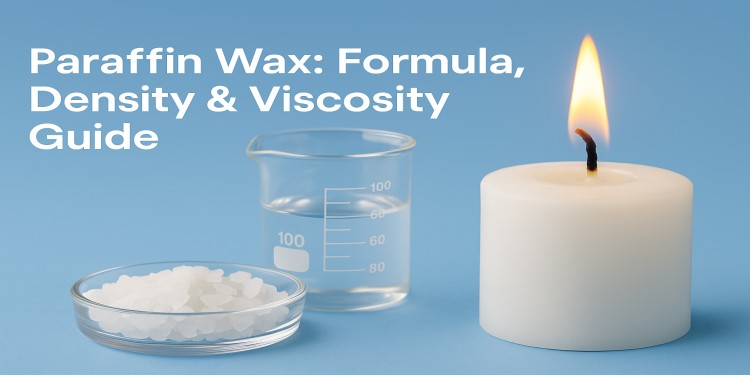Paraffin wax is a widely used substance in industries ranging from candle making to cosmetics, packaging, and even cable insulation. Despite its everyday applications, many users are unaware of its chemical nature, physical properties, and how these characteristics affect its behavior in different environments. In this article, we’ll break down the paraffin wax formula, explore the density of paraffin wax, and explain the viscosity of paraffin wax all in simple, understandable terms.

What Is Paraffin Wax?
Paraffin wax is a
white or colorless, odorless, and tasteless wax derived from petroleum, coal, or shale oil. It’s composed mainly of
long-chain saturated hydrocarbons, which give it its waxy texture and make it solid at room temperature. It’s prized for its
clean-burning properties,
smooth finish, and
versatility in various applications.
Paraffin Wax Formula
Chemically, paraffin wax is a mixture, not a single compound. However, its primary components are alkanes (also called paraffins) with the general molecular formula:
CnH2n+2
- The “n” in the formula typically ranges from 20 to 40 in paraffin wax.
- This means the wax contains hydrocarbons like C20H42, C25H52, or C30H62, depending on the specific grade and source.
These straight-chain hydrocarbons have no double or triple bonds, making the wax stable, non-reactive, and ideal for applications that require moisture barriers, insulation, or slow melting.
Density of Paraffin Wax
The density of paraffin wax varies slightly based on its purity and temperature, but it generally falls within the following range:
- At room temperature (20°C):
0.88 – 0.94 g/cm³
- In molten form (above 50°C):
The density slightly decreases due to thermal expansion.
Why Does Density Matter?
- In candle making, density affects burn time and wax volume.
- In packaging and insulation, it influences heat retention and structural integrity.
- For scientific formulations, accurate density helps determine mixture ratios and flow properties.

Viscosity of Paraffin Wax
The viscosity of paraffin wax refers to its resistance to flow when melted. Like most materials, its viscosity changes with temperature:
- At 100°C:
Viscosity ranges from 10 to 20 mPa·s, depending on chain length.
- At higher temperatures (130°C and above):
Viscosity decreases significantly, allowing easier pouring and molding.
Key Factors Affecting Viscosity:
- Chain Length: Longer hydrocarbons increase viscosity.
- Additives or Blending: Some industrial paraffin waxes are mixed with microcrystalline wax to increase viscosity.
- Purity Level: Cleaner, more refined wax tends to have lower viscosity.
Why Is Viscosity Important?
- In cosmetics, the spreadability and texture of lip balms and creams depend on wax viscosity.
- In cable manufacturing, proper viscosity ensures uniform coating and thermal insulation.
- In art and craft, it helps manage how easily wax pours into molds.
Paraffin Wax vs. Other Common Waxes
| Wax Type |
Source |
Melting Point |
Density (g/cm³) |
Notable Features |
| Paraffin Wax |
Petroleum |
46–68°C |
0.88–0.94 |
Affordable, clean burning, versatile |
| Beeswax |
Natural (bees) |
62–65°C |
0.95 |
Natural aroma, sticky texture |
| Soy Wax |
Soybean oil |
45–55°C |
0.90 |
Renewable, slower burning, creamy texture |
| Microcrystalline |
Petroleum |
60–90°C |
0.94–1.00 |
High viscosity, flexible, tacky texture |
Summary:
Paraffin wax is more cost-effective and versatile, while beeswax and soy wax are better for those seeking natural or eco-friendly alternatives. Microcrystalline wax is preferred in applications that require greater flexibility and adhesion.
Use Cases by Industry
Paraffin wax plays a critical role across various industries:
Candle Manufacturing
- Offers excellent scent throw and even burning.
- Easy to dye and mold due to low viscosity at melting point.
Cosmetics & Personal Care
- Used in lipsticks, balms, lotions for texture and consistency.
- Acts as a moisture barrier for skin.
Packaging
- Coats food wrappers, cartons, and paper for water resistance.
- Adds stiffness and durability.
Electrical & Cable Insulation
- Acts as a thermal and moisture barrier in cable gels and insulations.
- Viscosity and melting behavior allow precise application.
Pharmaceuticals
- Used as a binder or coating in tablets.
- Also utilized in therapeutic balms and salves.
Summary of Key Properties
| Property |
Value Range |
Notes |
| Chemical Formula |
CnH2n+2 (n = 20–40) |
Varies by source and processing |
| Density (20°C) |
0.88 – 0.94 g/cm³ |
Decreases with temperature |
| Viscosity (100°C) |
10 – 20 mPa·s |
Lower at higher temperatures |
Discover Quality You Can Rely On – Noor Wax
At Noor Wax, we specialize in producing high-purity paraffin wax with controlled density and viscosity for consistent results across industries. Whether you need bulk wax for candles, cosmetics, packaging, or industrial applications — we’ve got you covered.
Contact Noor Wax today for custom formulations, expert advice, and competitive pricing.
Email: Info@noorwax.com
whatsapp: +971522107592



send comments